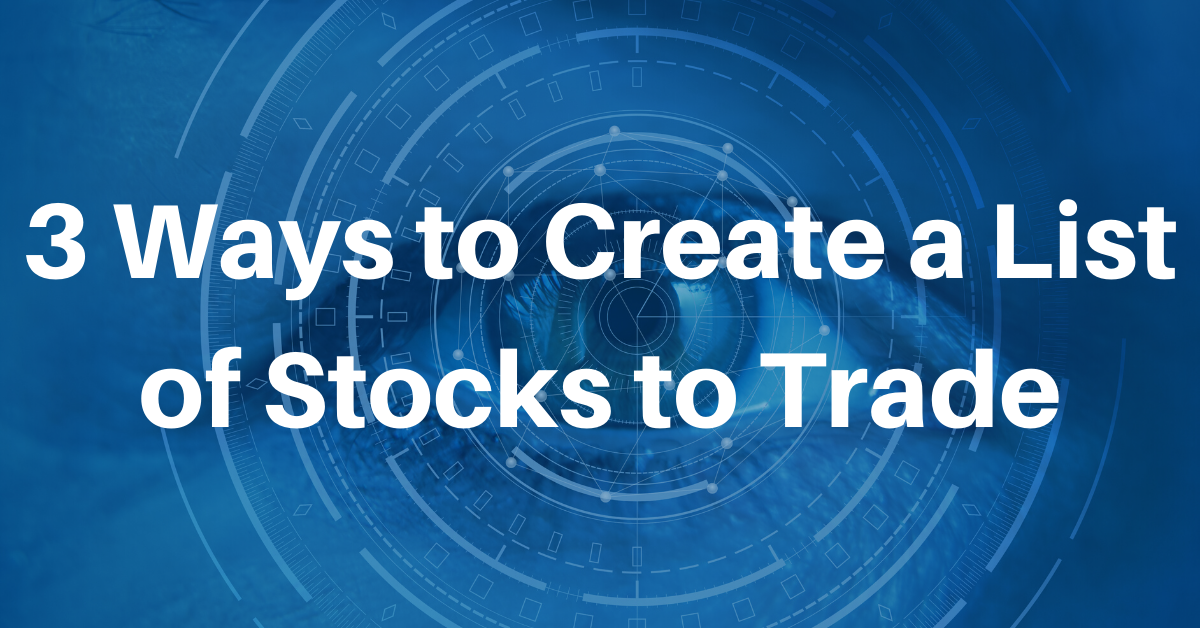How to Find Stocks to Trade

So many stocks to day trade, so many choices, so many opportunities…
A true professional admits resources of time, capital, experience and skill are limited. A sound trading plan is built around your resources, not your dreams. Having big aspirations is good.
Having unrealistic goals to match your resources is a path to deleting your account.
So what do you do?
How to Choose Stocks to Day Trade
There are three primary methods to generating swing trading ideas:
- Scanning for technical setups amongst all stocks.
- Choosing a non related list of stocks that meet certain volume and price action criteria.
- Choosing to trade certain sectors and industries.
Scanning for technical setups:
In this method you scan the entire listing of public companies. Done correctly you will filter the ideas down by volume, stock price and average true range. Let’s review the filtering criteria.
A volume filter will eliminate the stock without institutional interest. A general guideline for swing traders would be at least 500K shares traded per day on average over the last 30 days.
Stock price will filter ideas that you can afford to trade based on your buying power and available capital. If you trade on margin this number can be a little higher for you.
Average true range usually goes hand in hand with stock price but not always. The “ATR” will tell you the average range from high to low a stock normally trades. This will give you an idea of how volatile the price action can be.
One quick note on ATR, it can tell you how much you can earn if a stock moves in your favor and can be exciting if it moves a big distance but remember there are two sides to the coin. You also need to manage risk so be sure to choose and ATR within a normal price range that you can handle from a risk perspective.
The positive: Your pool of potential ideas is exposed to every catalyst and news story that occurs within the spectrum of the filtering criteria.
The negative: Stocks have personalities. It can be difficult to trade and manage risk in a stock you have never traded before.
Choosing a non related list of stocks that meet certain volume and price action criteria.
On the surface this may seem like the same as above but it’s not. Remember the negative above? Learning how a stock trades so you can trade it with conviction takes time.
In this method you are slowly cultivating a go-to universe of stocks that are your bread and butter. You may initially run the same scan as above but if the filter gives you a list of 80 potential stocks you pick 5-7 (for example) and only trade your best setups that week or month.
You keep those that you believe you can handle and offer the best risk reward scenarios and run another scan to repeat the process. After 3-6 months you will have your custom built universe of stocks to trade day-in and day-out to look for your edge and entries.
This is the preferred method of many professional traders.
Positive: Easy to trade with conviction as you are familiar with the price action. You never hesitate because you are in a stock that matches your resources and experience.
Negative: It will be tempting to stray from your list because of stocks in the news or simply a stock exhibiting volatile price action that you want to attempt to capitalize on. The negative can be perceived as lost opportunity.
Choosing to trade certain sectors and industries.
Many of us come to day trading with a full-time career that we understand intimately. This gives us an edge and insight into public companies within our knowledge base.
Whether you call this intuitive or simply experience you know what’s going on in the industry, so you choose stocks you understand. There are a couple of variations of this such as choosing hobbies or passions and sticking to those industries or simply choosing to learn an industry or two and mastering those arenas.
Positives: As you gain more experience you will understand how to take advantage of news catalysts that a purely technical trader will be able to. You will also have much better focus when opportunity is presented. This will also translate into confidence to trade more aggressively because. One thing to keep in mind “aggressive” does not always mean more shares, it could simply mean you hold trades much longer despite ups and downs of price action.
Negative: If your chosen industries fall out of institutional favor there could be less opportunity to earn money.
